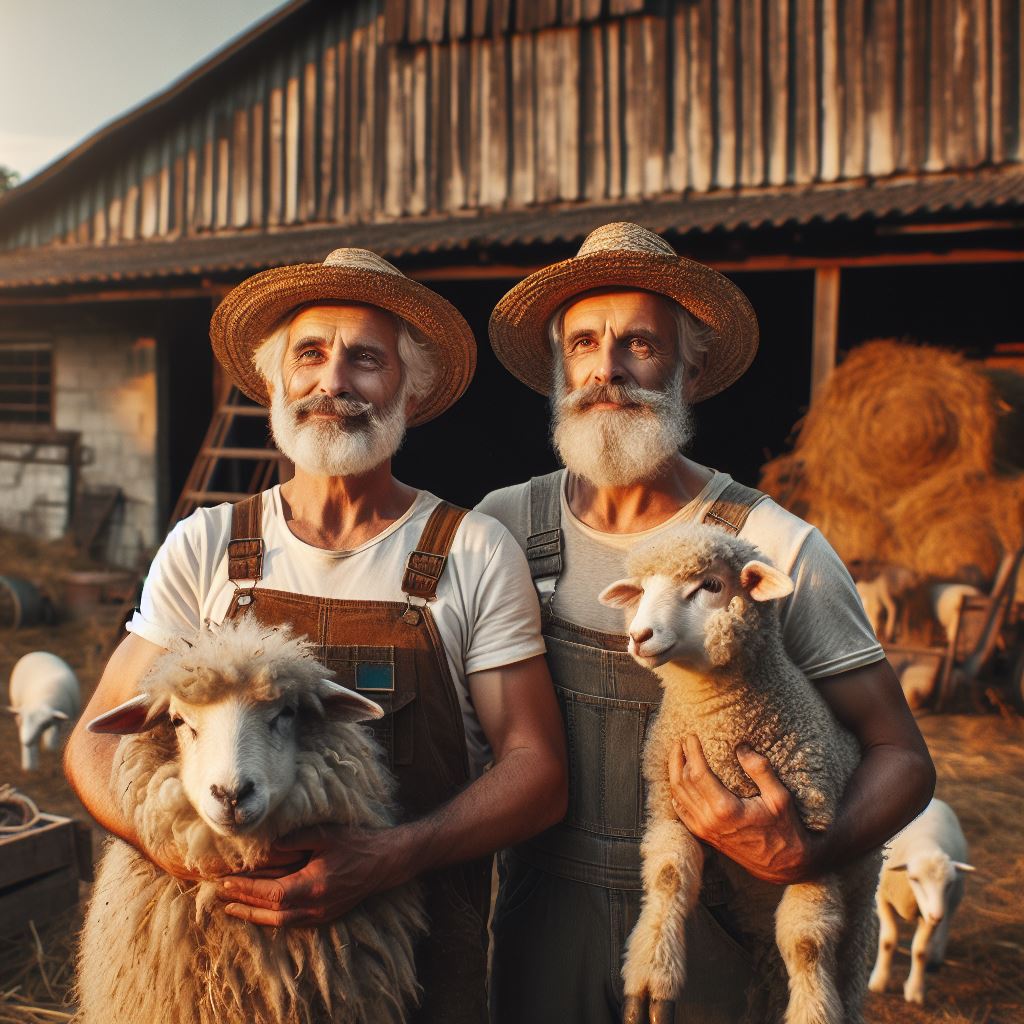Wool vs. Hair Sheep: What’s Best?
Last Updated on March 4, 2024
Introduction
Dive into the debate of wool vs. hair sheep breeds.
Uncover the unique characteristics, advantages, and considerations of each.
Whether you’re a seasoned shepherd or a newcomer, this comparison guides you in choosing the perfect fit for your flock.
Importance of sheep farming in agriculture
Sheep farming plays a vital role in agriculture, providing essential resources and economic benefits. However, not all sheep are the same.
Sheep farming plays a pivotal role in agriculture, contributing to sustainable practices and diverse product offerings.
From wool and meat to milk and manure, sheep provide valuable resources.
Their grazing habits also support land conservation.
Embracing sheep farming fosters ecological balance, economic viability, and a resilient agricultural landscape.
Brief explanation of the difference between wool and hair sheep
There are two main types: wool sheep and hair sheep.
These two variations have distinct characteristics and purposes, making a significant impact on the farming industry.
Wool sheep produce high-quality fleece, while hair sheep have a coarser coat used for different applications.
Characteristics and advantages of wool sheep
- Wool sheep are known for their highly versatile and valuable wool.
- They have a natural ability to grow a dense and soft coat.
- Wool sheep breeds include Merino, Rambouillet, and Lincoln.
- These breeds produce high-quality wool with varying textures and fiber lengths.
- Their wool is an essential raw material for various industries.
Description of wool sheep breeds
- Merino sheep are famous for their fine and soft wool, ideal for luxury garments.
- Rambouillet sheep have wool that is both soft and durable, making it perfect for a wide range of products.
- Lincoln sheep produce long and lustrous wool, suitable for upholstery and other durable fabrics.
High wool quality and various uses
- Wool from sheep is highly elastic, making it suitable for knitted fabrics.
- It has excellent insulating properties, keeping the sheep warm in cold temperatures.
- Wool is used in the production of clothing, blankets, carpets, and even mattresses.
- The textile industry extensively relies on wool for its natural temperature regulation.
Benefits of wool for clothing, insulation, and other industries
- Wool garments offer breathability, moisture-wicking, and natural odor resistance.
- It provides superior insulation, ensuring warmth even in wet conditions.
- Wool is commonly used in insulation materials for its fire-resistant properties.
- The automotive and construction industries utilize wool insulation to enhance energy efficiency.
Wool’s natural resistance to fire
- One of wool’s exceptional qualities is its ability to resist ignition and extinguish flames.
- Unlike synthetic fibers, wool does not melt or stick to the skin when exposed to fire.
- It acts as a natural barrier, limiting the spread of flames and reducing fire hazards.
The ability to dye wool in different colors
- Wool is easily dyed due to its high natural affinity for color pigments.
- It accepts dyes deeply and retains vibrant colors for extended periods.
- Dyed wool is used in the production of various textiles and decorative items.
- This versatility allows for a wide range of creative possibilities in the fashion and design industries.
In review, wool sheep possess remarkable characteristics and advantages.
Their high-quality wool is versatile and finds uses in various industries, including clothing, insulation, and manufacturing.
Wool’s natural resistance to fire and its ability to be dyed in different colors further contribute to its desirability.
Whether it’s for warmth, comfort, durability, or style, wool remains a top choice for many applications.
Characteristics and advantages of hair sheep
- Hair sheep have hair instead of wool, which means they do not need shearing.
- They have a higher tolerance to parasites and diseases compared to wool sheep.
- Hair sheep breeds have excellent adaptability to diverse climates and environmental conditions.
- Minimal maintenance is required for grooming and shearing since they naturally shed their hair.
- Hair sheep produce lean and flavorful meat, making them ideal for meat production.
Description of hair sheep breeds
- There are various hair sheep breeds, each with its own unique characteristics and qualities.
- Some popular hair sheep breeds include Katahdin, Dorper, St. Croix, and Barbados Blackbelly.
- Katahdin sheep are known for their excellent meat production and adaptability to harsh climates.
- Dorper sheep have a thick coat of hair and are prized for their fast growth and meat quality.
- St. Croix sheep are heat-tolerant and resistant to parasites, making them suitable for tropical regions.
- Barbados Blackbelly sheep have distinctive black markings and are highly adaptable to various environments.
Adaptability to diverse climates and conditions
- Hair sheep breeds are known for their ability to thrive in different climatic conditions.
- They can withstand extreme heat, high humidity, and harsh winter conditions.
- This adaptability makes them suitable for a wide range of geographic regions.
- Hair sheep are well-suited for both arid and tropical climates, as well as temperate regions.
Minimal maintenance required for grooming and shearing
- Hair sheep do not require regular shearing since they naturally shed their hair.
- This saves time and money, as there is no need to hire shearers or invest in shearing equipment.
- They also do not need extensive grooming, as their hair does not mat or form woolly clumps.
- Regular brushing or combing is sufficient to keep their coat in good condition.
Tolerance to parasites and diseases
- Hair sheep have a higher tolerance to parasites and diseases compared to wool sheep.
- They are less susceptible to common sheep ailments such as wool maggots and wool blindness.
- This natural resistance reduces the need for frequent medical intervention and management.
- Tolerance to diseases also contributes to better overall health and productivity of hair sheep.
Lean and flavorful meat production
- Hair sheep are highly prized for their meat, which is lean, tender, and flavorful.
- Their meat has a milder taste compared to wool sheep, making it more appealing to a wider audience.
- Due to their natural ability to efficiently convert food into meat, they have good carcass yield.
- Meat from hair sheep is often sought after by discerning consumers and culinary professionals.
more, Further By highlighting the characteristics and advantages of hair sheep, it is clear that they offer numerous benefits in terms of adaptability, low maintenance, and quality meat production.
Whether it’s their natural shedding, tolerance to parasites and diseases, or ability to thrive in diverse climates, hair sheep prove to be a valuable choice for farmers and consumers alike.
Read: Organic Livestock: Pros & Cons
Factors to Consider When Choosing Between Wool and Hair Sheep
When deciding between wool and hair sheep, there are various factors that must be carefully considered.
Climate and Environmental Conditions
- The first factor to contemplate is the climate and environmental conditions.
- Wool sheep tend to thrive in cooler climates, while hair sheep are more adaptable to warmer regions.
- If you live in a hot and humid area, hair sheep might be the better option.
- On the other hand, if you reside in a colder region, wool sheep could be more suitable.
Farming Goals and Objectives
- Your farming goals and objectives are crucial in making this decision.
- If your aim is to produce high-quality wool for textile industries, wool sheep are the obvious choice.
- However, if you are primarily interested in meat production, hair sheep are more suited for this purpose.
- Consider your long-term farming plans and choose the breed that aligns with your goals.
Market Demand and Profitability
- Market demand and profitability play a significant role in the decision-making process.
- Research the market demand for wool and hair products in your area.
- Ensure there is a steady market for the sheep products you intend to sell.
- Choose the breed that is more likely to generate higher profits in your specific market.
Personal Preferences and Interests
- Personal preferences and interests should not be overlooked when making this important choice.
- Consider the aspects that personally appeal to you, whether it’s the feel of wool or the simplicity of hair sheep.
- Think about the activities you enjoy doing on your farm and how each breed can complement your lifestyle.
- Ultimately, you want to work with sheep that bring you joy and satisfaction.
Availability of Resources and Infrastructure
- The availability of resources and infrastructure in your area is another vital factor.
- Wool sheep require more resources, such as shearing equipment and proper wool handling facilities.
- Consider whether you have access to these resources or if you are willing to invest in them.
- Hair sheep, on the other hand, have lower maintenance requirements and may be more suitable if resources are limited.
When deciding between wool and hair sheep, it’s important to carefully consider these factors.
Assess the climate, define your farming goals, research the market, determine your personal preferences, and evaluate available resources.
Essentially, By taking these factors into account, you can make an informed decision that best suits your needs and circumstances.
When deciding between wool and hair sheep, it’s important to carefully consider these factors.
Assess the climate, define your farming goals, research the market, determine your personal preferences, and evaluate available resources.
By taking these factors into account, you can make an informed decision that best suits your needs and circumstances.
Read: Meat Goats: Breeds and Management

Challenges and considerations for wool sheep farming
When it comes to wool vs. hair sheep, there are several challenges and considerations that wool sheep farmers need to take into account.
Let’s explore these factors in more detail:
Frequent Shearing and Labor-Intensive Wool Processing
Wool sheep require regular shearing to prevent their wool from becoming too long and unmanageable.
This process is labor-intensive and requires skilled shearers. It can be time-consuming and costly for farmers.
Maintenance of Sheep’s Wool Quality
Maintaining the quality of wool is crucial for wool sheep farmers.
This involves proper nutrition, health care, and managing external factors such as weather conditions and parasites.
Ensuring the quality of wool adds to the complexity of wool sheep farming.
Higher Vulnerability to Cold and Wet Environments
Wool sheep are more susceptible to the cold and wet conditions compared to hair sheep.
Their dense wool provides insulation but can also become a disadvantage in extremely cold or wet climates.
Proper shelter and management are essential to protect the well-being of wool sheep.
Potential Risk of Wool-Related Diseases and Parasites
Wool sheep are prone to specific diseases and parasites that affect their wool, such as wool rot, flystrike, and lice infestations.
Farmers need to implement preventive measures and regularly monitor their flock to minimize the risk of wool-related health issues.
Despite these challenges, wool sheep farming also has its advantages:
Wool as a Valuable Fiber
Wool is a versatile and valuable fiber with a wide range of applications.
It is used in the textile industry for clothing, carpets, and upholstery.
The demand for high-quality wool remains strong, providing potential income opportunities for wool sheep farmers.
Resilience and Hardiness
Wool sheep have evolved over centuries to adapt to various environments.
They possess natural resilience and hardiness, making them suitable for different climates and landscapes.
Their ability to withstand adverse conditions can be an advantage for farmers in certain regions.
Potential for Higher Profitability
Due to the higher value of wool compared to hair, wool sheep farming has the potential for higher profitability.
If managed effectively, wool production can generate a considerable income stream for farmers.
In summary, wool sheep farming poses unique challenges and considerations for farmers.
The frequent shearing and labor-intensive wool processing, maintenance of wool quality, vulnerability to cold and wet environments, and the potential risk of wool-related diseases require careful management.
However, the value of wool as a fiber, resilience of wool sheep, and the potential for higher profitability make wool sheep farming an attractive venture for many.
By understanding these factors and implementing proper farming practices, farmers can successfully navigate the world of wool sheep farming.
Read: Goat Breeding Essentials: What to Know
Challenges and Considerations for Hair Sheep Farming
When it comes to sheep farming, there are various considerations and challenges specific to hair sheep breeds.
These factors play a crucial role in determining the success and profitability of hair sheep farming ventures.
In this section, we will discuss some of the key challenges and considerations for hair sheep farming to help you make informed decisions.
Availability of Suitable Grazing Lands and Forage
One of the main challenges faced by hair sheep farmers is the availability of suitable grazing lands and forage.
Hair sheep breeds require access to high-quality pastures and forage, such as grasses, legumes, and browse, to meet their nutritional requirements.
Ensuring access to ample grazing lands can be a significant consideration for those looking to venture into hair sheep farming.
Marketing and Consumer Awareness of Hair Sheep Products
Another important consideration is the marketing and consumer awareness of hair sheep products.
While hair sheep offer numerous benefits, such as tender meat and resistance to parasites, consumers may not be familiar with these advantages.
Educating consumers about the superior qualities of hair sheep products can help expand the market and drive demand.
Potential Difficulty in Finding Suitable Hair Sheep Breeds
Unlike wool sheep, which have a wide range of recognized breeds, finding suitable hair sheep breeds can be challenging.
The availability and selection of suitable hair sheep breeds may be limited depending on your geographical location.
Conducting thorough research and consulting with experienced hair sheep farmers can help identify breeds that thrive in your specific climate and production goals.
Proper Meat Handling and Processing Techniques
Proper meat handling and processing techniques are essential for maintaining the quality and safety of hair sheep meat products.
Unlike wool sheep, hair sheep have leaner meat, which requires specific handling practices to prevent drying and maintain tenderness.
Familiarize yourself with proper meat processing protocols to ensure the highest quality products for your customers.
In closing, As with any farming venture, hair sheep farming comes with its own set of challenges and considerations.
From ensuring access to suitable grazing lands and forage to educating consumers about hair sheep products, thorough planning and research are crucial for success.
By addressing these challenges and considering these factors, you can make informed decisions and pave the way for a profitable hair sheep farming business.
To read more about the topic, “Wool vs. Hair Sheep: What’s Best?” and explore the advantages and challenges of both types of sheep farming, check out the complete blog or chapter series.
Read: Dairy Goats 101: Breeding & Care
Learn More: Dairy Cow Diet Essentials for Maximum Milk Yield
Conclusion and Final Thoughts
After exploring the differences between wool and hair sheep, it is clear that choosing the best option depends on individual farming needs and goals.
Both types of sheep offer unique advantages and disadvantages.
Summary of Key Points Discussed
Throughout this blog post, we have discussed the various characteristics of wool and hair sheep.
We examined their wool/hair production, adaptability to different climates, and meat quality.
Additionally, the differences in maintenance requirements, market demand, and profitability were highlighted and compared.
Importance of Assessing Individual Farming Needs and Goals
It is crucial for farmers to evaluate their specific needs and objectives before deciding between wool and hair sheep.
Factors such as climate, available resources, target market, and personal preferences should be taken into consideration.
Encouragement to Consult with Experts and Experienced Sheep Farmers
Seeking advice and guidance from experts and experienced sheep farmers is paramount in making an informed decision.
These individuals possess a wealth of knowledge and can provide valuable insights based on their firsthand experiences.
Emphasis on the Diversity and Versatility of Sheep Farming
Sheep farming, whether focused on wool or hair production, offers immense diversity and versatility.
Farmers have the opportunity to tailor their operations to meet their unique goals and interests, contributing to a thriving and sustainable industry.
Ultimately, the question of whether wool or hair sheep are best cannot be definitively answered.
It depends on the individual’s circumstances, goals, and preferences.
By assessing their needs, consulting with experts, and acknowledging the diverse opportunities within sheep farming, individuals can make the best decision for their farming ventures.


